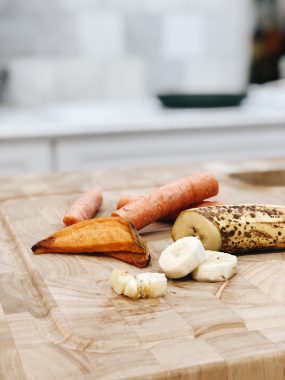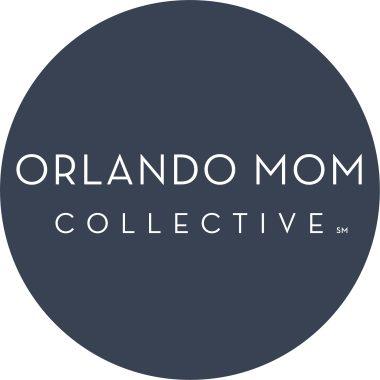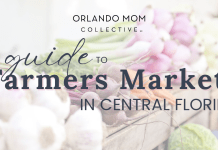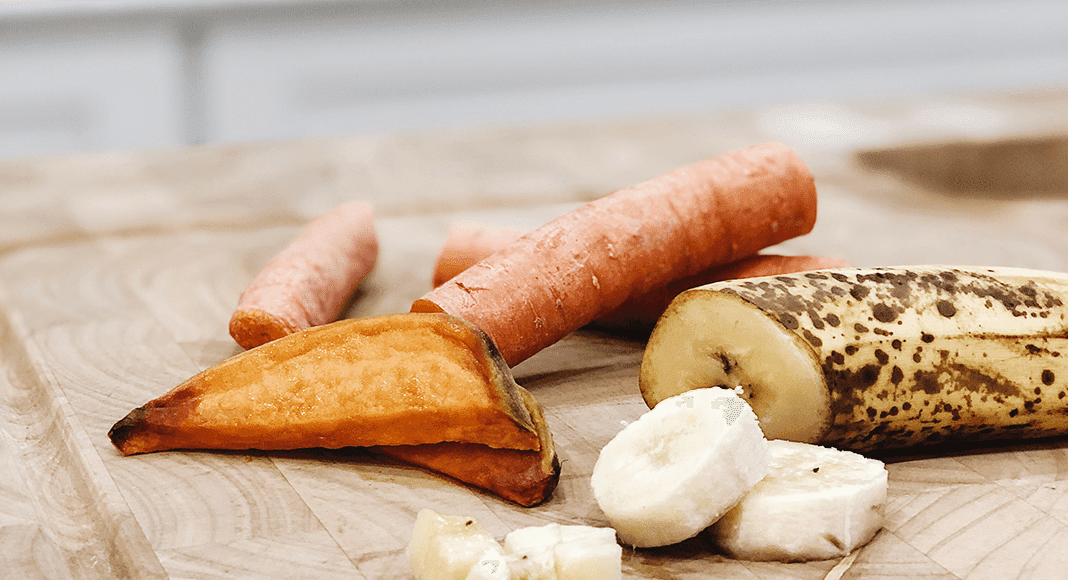It’s hard to believe it’s been over 7 months since we had our babies, and as you can guess, we are enjoying every single moment. Shannon welcomed her first this past April, while Jenna welcomed her last (just six days prior!), and we’ve been enjoying reaching new milestones and witnessing our babies’ unique development along the way. As we were reaching the six month mark, we both received the green light from our pediatricians to begin starting baby on solids, and we couldn’t wait to introduce them to new tastes and textures.

Shannon has been learning how fun it is to introduce solids to Max, while Jenna is relearning proven techniques and introducing some new ones to Charley Lynn. It’s clear that every baby is different when it comes to reaching new milestones, but we both agree there are some simple steps and helpful tools that make the process a bit easier for both baby and mom.
If your baby is about to start eating solids, read through these simple steps to make the experience fun and enjoyable.

Starting Baby on Solids – Simple Steps:
1. Consult with your pediatrician.
Before deciding to introduce solids to your baby, always, always consult with your pediatrician. Your pediatrician is your partner in providing the best care for your little one(s), and based on your baby’s specific needs and development, will be able to help you determine the best time to introduce solid foods. The American Academy of Pediatrics recommends starting baby on solids around 6 months of age and exposing them to a wide variety of healthy foods and textures.
2. Find reliable resources to help you design a schedule that fits your lifestyle and parenting style.
One of the most important aspects of parenting is finding routines and rhythms that work for both you and baby. This doesn’t mean you have to follow a rigid schedule, however. Instead, you will design a general daily guide to help plan your days around, especially when you begin starting baby on solids.
We have both been loyal fans of the Moms on Call method since our babies were newborns, and their method to introducing solids has been so helpful! With approval from our pediatricians, we’ve used it mostly to guide us on “when” to feed solids throughout the day and the type of solids to introduce. It has certainly helped ease the process and provide some structure to our days, so they don’t feel so chaotic or haphazard.
3. Pay attention to baby’s cues and not the calendar.
This is such an important factor to keep in mind. Just because your baby is reaching a certain age, does not necessarily mean he or she is ready for solid food. In fact, even though our babies were only born 6 days apart, Max was ready for solids much earlier than Charley. Max is currently eating 2-3 different types of solids up to three times a day, while Charley is still learning to like them. Either way, your baby will provide cues when he or she is ready.
If your baby does not seem to be ready, (whether he or she is completely refusing to eat the solids or they do not agree with their digestive system) don’t get discouraged. Speak with your pediatrician and plan to try again sometime soon. Slowly but surely, they’ll be eating an array of solids that will help with the transition when it comes time to wean.
4. Invest in tools that will help ease the process for both you and baby (see below).
We’d be remiss if we didn’t mention, starting baby on solids can be quite messy! From preparing the foods (if you’re making your own), to baby trying to grab the spoon and/or spitting food out while learning to eat, be prepared for a mess of purees for the next month or so. You will want to have seating for both you and baby that provides comfort and functionality, utensils and accessories that are suitable for baby, and plenty of tools to help limit and clean up the mess!
5. Have fun and enjoy this new milestone!
There is nothing more fun than watching your baby reach new milestones, and starting baby on solids is certainly one of them. Because babies are still meeting 100% of their nutritional needs from breastmilk or formula until they are 12 months old, there is no need to stress how much of the solids they eat. Sometimes they may only take a few spoonfuls, while other times they may be interested in eating much more. It will be a gradual process at first, and as long as you’re having fun, baby will be more at ease trying new tastes and textures.

Tips for Introducing Solid Foods to Baby
- Relax and have fun! Your baby looks to you to help him or her understand the world around them. If you’re relaxed, he or she will be more relaxed, and if you’re having fun, he or she will have fun too!
- When trying new foods, you can rub a little bit on the inside of their arm (near where the elbow creases) and wait a little while to see if they have a reaction. If they do, consult with your pediatrician whether to offer that food or not.
- Nurse or bottle feed prior to offering solids to ensure baby consumes a sufficient amount of breastmilk or formula for the day.
- Wait about an hour after breastfeeding or formula feeding before offering solids.
- Use spoons with long handles. You will have better control, especially when baby tries to grab the spoon.
- Let baby do most of the work with the spoon. Simply put the spoon in baby’s mouth and allow it to sit there while you hold it.
- Offer new foods in the morning, during the week and while you are near your pediatrician in case it does not agree with your baby. This way if he or she has an adverse reaction, you’ll have access to your pediatrician, and if it upsets their tummy, it will not disrupt nighttime sleep.
- If making your own baby purees, mix breastmilk or formula with the food, keeping in mind how long breast milk/formula stays good for.
- If making your own baby purees, consider prepping batches in advance for food like apples, pears, carrots, squash, etc. You can freeze these foods after pureeing them and mix in breastmilk or formula when you are ready to feed.
- Begin with very pureed solids and thicken the consistency over several weeks.
First 2 Weeks: Stage 1 Baby Food – Very Pureed
Next 2 Weeks: Stage 2 Baby Food – Thicker Puree
Up to 7 Months: Stage 3 Baby Food – Thickest Puree
- Offer both fruits and vegetables, for a variety of flavors and textures.
- Offer veggies before fruits during a feeding. Fruits will always taste better than veggies, so offer veggies when baby is hungrier.
- When introducing a new food, offer that same food for 3 or 4 days in a row. This helps you better identify any allergies and allows baby to get used to a new taste and texture.
- If baby rejects a new food, try offering it again and again. You may have to offer it 10-15 times over several months before baby learns to like it.
- If offering baby food from a jar, do not feed baby straight from the jar. Bacteria from baby’s mouth will contaminate the jar of food via the spoon.
- Refrigerate open and uncontaminated jars of baby food for up to 48 hours.
- Offer breastmilk or formula or *water (*consult with your pediatrician regarding water consumption) while feeding baby solids.

Starting Baby on Solids – Helpful Tools:
1. Seating
One of the most helpful tools while starting baby on solids is the highchair. Functional and comfortable seating essentially sets both you and baby up for success. It sets baby at a height that allows you to sit yourself in front of comfortably. It also sets baby in a seated position best suited for eating solid foods and provides an area for the mess to land on.
A few key factors to consider when choosing a highchair are:
- Size
- Function
- Ease to keep clean
- Comfort
- Quality
- Design
- Reviews
2. Utensils & Accessories
When selecting utensils and accessories for starting baby on solids, choose tools that are soft, slip resistant, intended for babies and are easy to travel with.
Essential utensils and accessories include:
- Spoons
- Bibs
- Plates/Bowls
When it comes to bowls and plates, opt for those with a suction base to avoid a further mess on your baby and the surroundings. These days, finding baby-friendly tableware is no hassle, from weaning suction bowls to suction plates and sippy cups for toddlers; everything is affordable and of high quality for the tiniest of human beings.
3. Messes
Consider yourself warned; starting baby on solids can be a messy job, and oftentimes, food will end up on the floor, all over baby’s face and hands and even in their hair.
- Mats – Protect your floors from unwanted stains (hello, carrots) by placing a mat under the highchair that is wipeable and water resistant.
- Soft, Wet, Reusable Cloths – We found baby’s face can be sensitive to wet wipes, and we’ve been making efforts to be more environmentally friendly, so wet washcloths have been doing the trick for us. They’re perfect not only for wiping baby’s face but also wiping their hands and cleaning up the mess on and around the highchair when done.
4. Preparation & Storage
Since we are home with the babies, we both decided to make our own baby food, and quite honestly, it’s easier than we thought! Peel, chop, puree, and you’re ready to feed!
- Preparation – For this category, we ended up choosing different tools. Jenna chose a baby specific food maker, while Shannon chose a blender that works for baby and in the future, general prep in the kitchen. Nonetheless, they help us prepare our babies’ food within minutes.
- Storage – One of the best time-saving tips is to make batches of baby food in advance. From there, you can freeze what you prepare and thaw as needed. *We only advise mixing breastmilk or formula into your purees if planning to feed immediately. Look for glass storage containers with measurements labeled on the side that can go straight from the freezer to the microwave or oven. They’re even better if they can be stacked for easy storage and have easy to snap, leak-proof lids.
Initially, it seemed like a lot came with starting baby on solids, but now that we’re getting the hang of it and have tips and tools to guide us, we’re just having fun with it. A typical schedule has also helped us find time for our babies to practice eating solids that doesn’t interfere with their daily breastmilk or formula intake. Furthermore, knowing what foods to try first has helped us ensure they try a variety of tastes and textures.
So tell us, what’s been your favorite part of introducing solids to your baby? Is it the cute little faces they make when they try something new, or opening their mouth wide and getting excited when the spoon is coming their way? We’d love to hear in the comments below!



















This was so detailed and thorough! Thank you for all of these wonderful tips!😀❤️❤️❤️